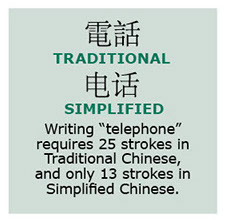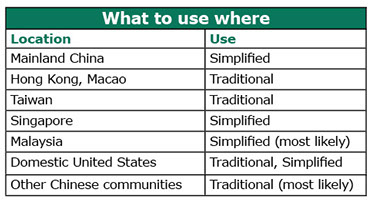ARTICLES
When to Use Simplified
or Traditional Chinese
As China’s influence and economic power have increased, demand for Chinese translations has grown as well. With over 1.3 billion people speaking some form of Chinese, it’s no wonder. We frequently get requests for translation into Mandarin or Cantonese Chinese, but then the question becomes which version is most appropriate for a given region? The answer is neither. Rather, you should ask for Simplified or Traditional Chinese.
Many people have heard the terms Mandarin and Cantonese, but few outside of the Chinese-speaking world know the difference. Both are dialects of spoken Chinese. Some 850 million speakers communicate in Mandarin, while over 70 million speak Cantonese. As many as 13 dialects of Chinese are spoken, most of which are mutually unintelligible.
However, for more than a millennium speakers of different dialects have been able to communicate via Traditional Chinese in written form because it was universally taught (at least to the elite) and the characters have intrinsic meaning independent of their sounds.
The Chinese writing system is probably the oldest continually used system on Earth. Chinese is written with a series of characters that are used to represent objects such as 人 for a person or abstract notions such as 上 for “up.”
 Many Chinese characters are grouped together to form new terms or concepts.
Many Chinese characters are grouped together to form new terms or concepts.
For example, the English word telephone uses two Chinese characters, 電 (electric) and 話 (speech), which appear as 電話 in Traditional Chinese.
Written Chinese: Simplified vs. Traditional
Written Chinese actually has two standards: Traditional and Simplified. In Traditional Chinese, a character may
 require 25 or more writing “strokes” completed in a specific order. Simplifying the writing system by reducing the number of strokes per character was seen as one way to boost literacy. However, the resulting simplification now makes it difficult for many in mainland China to read the traditional version of the characters.
require 25 or more writing “strokes” completed in a specific order. Simplifying the writing system by reducing the number of strokes per character was seen as one way to boost literacy. However, the resulting simplification now makes it difficult for many in mainland China to read the traditional version of the characters.
The origins of this division lie in modern-day politics. After their victory in 1949, the communist Chinese government sought to expand literacy by reducing the number of strokes in Chinese characters; hence, Simplified Chinese was born. Although the Republic of China, which fled to Taiwan, rejected simplified characters, publications from abroad with simplified characters can be imported and distributed. In contrast, the city-state of Singapore officially adopted the Simplified Chinese characters after a series of reforms beginning in 1969. In 1981 Malaysia followed with a set of simplified characters used in Chinese-language schools in that country.
Historically, many Chinese residing in countries outside of Mainland China, notably the United States, continued to use Traditional Chinese writing. In the past ten to fifteen years, however, we are seeing more requests for Simplified Chinese for the domestic U.S. market to accommodate the more recent waves of Chinese immigration from the Mainland. The former colonies of Hong Kong (Britain) and Macao (Portugal) also continue to use traditional characters, although the influence of Simplified Chinese is beginning to be felt.
Given the significant differences between Simplified and Traditional Chinese, and the potential political fallout over choosing the “wrong” version, we will always ask you about the target market of your translation.
